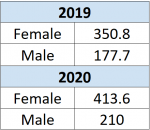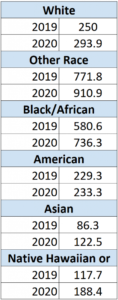By Carl Letamendi & Brantley Scott
The U.S. Department of Veteran Affairs/National Center for Post-Traumatic Stress Disorder (NCPTSD) recognizes June as Post-Traumatic Stress Disorder (PTSD) Awareness month. According to the NCPTSD, “PTSD is a mental health problem some people develop after experiencing or witnessing a life-threatening event, like combat, a natural disaster, a car accident, or sexual assault”.[1] While generally, people associate PTSD with experiences and stressors of exposure to combat, other factors can also result in PTSD. These factors include, but are not limited to: childhood sexual abuse, experiencing community violence, and intimate partner violence.[2] This means PTSD has an impact on not only members of the armed forces; children and teenagers are also susceptible to trauma, some of which develops into PTSD.[3]
In response to the national observation of PTSD Awareness Month, the Utah Department of Health Office of Health Care Statistics (OHCS) produced this databyte to provide a snapshot of PTSD for 2019 and 2020, as well as make observations across several subgroups, as the data allow. This analysis uses the Utah Healthcare Facility Database (HFD), which contains encounter records for all licensed hospitals, emergency rooms, and ambulatory surgery centers in Utah. These data represent all hospitalizations, emergency department visits, ambulatory surgeries, and diagnostic procedures performed in Utah regardless of payer. For the purpose of this analysis, three ICD-10 codes were used:
- F43.10 Post-traumatic stress disorder, unspecified;
- F43.11 Post-traumatic stress disorder, acute; and,
- F43.12 Post-traumatic stress disorder, chronic.
While more than a dozen diagnoses are available for any particular encounter, this analysis limited it to the first seven diagnoses available. It is relatively uncommon for several diagnoses to be observed for any given encounter. The following tables show the number of Utahns with a PTSD diagnosis for calendar years 2019 and 2020, by sex, age groups, and local health district. To date, population estimates are not readily available for 2020 to facilitate comparing both years, so this snapshot observes counts for both years, and uses population estimates for 2019 to estimate rates. Any notable increases or decreases observed from year to year could be influenced by population changes, which is not fully captured in this analysis. Subsequent work could be done to update this analysis once population estimates are available for 2020. In total, 12,661 encounters for PTSD were generated for 8,171 members in 2019, and in 2020, 9,593 members generated 14,284 encounters for PTSD.
With regard to PTSD by sex, females had higher numbers of PTSD diagnoses compared with males. In 2019, 5,614 females and 2,878 males, and in 2020 6,619 females and 3,402 males had a diagnosis of PTSD. Across both groups, the number of those with PTSD increased from 2019 to 2020, 17.9% for females and 18.2% for males.[4]
Figure 1. PTSD diagnoses in Utah, by sex, 2019 & 2020
Table 1. PTSD Rates per 100,000 People, by Sex

Racial categories available in the HFD include: American Indian/Alaska Native, Asian, Black/African American, Native Hawaiian or Other Pacific Islander, Other Race and White. When making observations across all racial groups, the data show that across all racial groups, 2020 saw more people with PTSD compared with 2019. Data submitted by healthcare facilities also includes a flag for Hispanic/Latino. In 2019, 835 Utahns who are Hispanic/Latino had a diagnosis for PTSD, 904 in 2020. It is unclear if there are certain nuances across any of these groups that result in the numbers we observe, such as a greater or lesser likelihood of having healthcare coverage or any other barriers which result in aversion to the healthcare system altogether.
Despite the low counts, the top three racial groups with the highest rate increase of people with PTSD between 2019 and 2020 were people who are Native Hawaiian or Other Pacific Islander (60% increase), Asian (41.9% increase). and Black/African American (26.8%).[5] Moreover, there was an 8.3% increased rate of people who are Hispanic/Latinos[6] with PTSD in 2020 compared with the year prior; 16.6% increase for people who are non-Hispanic/Latino[7].
Figure 2a. PTSD diagnoses in Utah, by race, 2019 & 2020
Figure 2b. PTSD diagnoses in Utah, by ethnicity, 2019 & 2020
Table 2a. PTSD Rates per 100,000 People, by Race

Table 2b. PTSD Rates per 100,000 People, by Ethnicity

Figure 3 and table 3 depict the number of people with a PTSD diagnosis, by age group. Across most age groups, except for the 0–17 and 80–84 age group, the number of Utahns with a PTSD diagnosis increased from 2019 to 2020. The age group with the largest increase in rate for PTSD diagnosis was those in the 18–24 age group (35.7% increase).[8]
Figure 3. PTSD diagnoses in Utah, by age groups, 2019 & 2020
Table 3. PTSD Rates per 100,000 People, by Age Group

In these last observations, we explored PTSD diagnoses by Utah’s 13 local health districts. Across 11 of the 13 local health districts, the number of people with a PTSD diagnosis increased from 2019 to 2020. The two exceptions were the Southeast and Summit local health districts. The local health districts with the top three highest rates per 100k in the population, when comparing change from 2019 to 2020, are Davis (43.3% increase), Central Utah (41.8% increase) and Wasatch (29.5% increase).
Figure 4. PTSD diagnoses in Utah, by local health district, 2019 & 2020
Table 4. PTSD Rates per 100,000 People, by Local Health District

According to the National Alliance on Mental Illness, several treatment options are available for those with PTSD. These include psychotherapy, medications, and self-management strategies.[9]
The Utah Department of Health OHCS is committed to bringing this critical public health issue to light. If you feel you may be experiencing symptoms of PTSD, we encourage you to contact a mental health provider to discuss further options. For questions regarding resources within the Utah Department of Health, please call the Health Resource Line at 1-888-222-2542. Other crises and crisis-related hotlines can be found here.
[2] https://www.ptsd.va.gov/PTSD/understand/types/index.asp
[3] https://www.ptsd.va.gov/understand/common/common_children_teens.asp
[4] Statistically significant at the .05 level
[5] Statistically significant at the .05 level
[6] Results did not pass test of statistical significance
[7] Statistically significant at the .05 level
[8] Significant at the .05 level, excel for the 0-17, 80-84 and 85+ age groups
[9] https://www.nami.org/About-Mental-Illness/Mental-Health-Conditions/Posttraumatic-Stress-Disorder